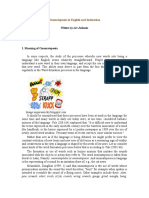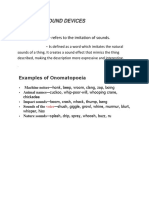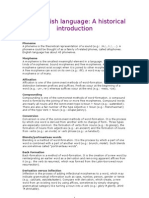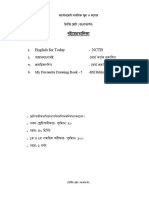What Is An Onomatopoeia
What Is An Onomatopoeia
Uploaded by
wysacadCopyright:
Available Formats
What Is An Onomatopoeia
What Is An Onomatopoeia
Uploaded by
wysacadOriginal Title
Copyright
Available Formats
Share this document
Did you find this document useful?
Is this content inappropriate?
Copyright:
Available Formats
What Is An Onomatopoeia
What Is An Onomatopoeia
Uploaded by
wysacadCopyright:
Available Formats
What is an onomatopoeia?
Onomatopoeia, pronounced ah-nuh-mah-tuh-PEE-uh, refers to the practice of
naming something based on a phonetic (spoken) imitation of a sound
associated with it. It can also refer to a single word of this kind: Hiss is an
onomatopoeia. Buzz, chirp, and honk are all also examples of onomatopoeia.
As with so many other words in the English language, we have classical
Greek to thank for onomatopoeia, which originates from the words onoma,
meaning “name,” and poiein, meaning “to make.”
In a way, onomatopoeias are a human attempt to bypass the step of
translating something into language altogether by just reproducing a sound in
order to refer to the thing or action that makes it. One thing that makes these
words fascinating is the way they fail to fully do that. For example, roosters
make the same sound all over the world, but the onomatopoeias for that
sound vary in different languages: In English, roosters are thought to say
“cock-a-doodle-do.” In Spanish, it’s “quiquiriquí.” In Tagalog, it’s “tiktiláok.” In
Hindi, it’s “ku-kudu-koo.”
This hybrid nature of onomatopoeias—the fact that they both imitate natural
sounds and are shaped by human language—makes them potent ingredients
to sprinkle into any kind of writing where you want the reader to be especially
aware of the sounds and texture of language.
When are onomatopoeias used?
Onomatopoeia is a figure of speech that is used in both speech and writing.
When you’re talking or writing about the physical world, the use of
onomatopoeia can make your language more vividly expressive.
There are a few general categories of language that are particularly rich with
onomatopoeias.
The animal kingdom
Onomatopoeias come in very handy when describing the animal kingdom.
There are many that represent the sounds animals themselves make, such
as meow or purr for a cat, bark or woof for a dog, quack for a duck,
and oink for a pig. These words generally function as both nouns and verbs:
I could hear the dog’s bark from around the corner.
The dog barked so loudly that I could hear her from around the corner.
Another way that onomatopoeias become attached to animals is when an
animal is named after the sound it makes. For example, many birds are
named for their calls, including the cuckoo, the bobwhite, and the chickadee.
Human sounds and actions
There are many onomatopoeias for sounds humans make and/or for actions
associated with certain sounds. Some examples
include achoo, belch, gargle, growl, hiccup, murmur, and snore.
Nature and objects
The language we use when we’re talking about nature and inanimate objects
supplies plenty of onomatopoeias. For example, the sounds associated with
water give us splash, gurgle, drip, sprinkle, and more. Objects colliding with
each other can clink, clatter, clang, or bang. The machines we use
may beep, buzz, chug, click, ding, honk, hum, or zap.
3 types of onomatopoeia
Writers, linguists, and literary scholars have been suggesting ways of sorting
onomatopoeias into categories for hundreds of years, and there’s still no
definitive list of such categories that is widely agreed on. The following three
groupings are one framework for thinking about the different ways
onomatopoeia can function, from narrowest to broadest.
1 Onomatopoeias that name sounds
The most basic and direct kind of onomatopoeia is a word that simply names
a sound by imitating it. Many of the examples of onomatopoeic words we’ve
already seen belong in this category, along with other words
like moan, whir, clack, rustle, and thud.
2 Onomatopoeias that name things connected with sounds
The bird names we discussed in the previous section—cuckoo, whip-poor-will,
and chickadee—are examples of this second type of onomatopoeia, one
degree removed from sound itself. These words don’t refer to a sound but to
something that has a certain sound associated with it. Another example is the
word whip—a whip is an object named for the sound it makes when in use; it
is not itself a sound.
3 Onomatopoeias that mimic something else physical
With this third, loosest type of onomatopoeia, the way a word is vocalized
relates physically to what it means, but the comparison is not to a sound. Two
good examples are the words smooth and craggy. It doesn’t take much effort
to say smooth, and the absence of hard consonants makes its sound
resemble the soft, unbroken feel of a smooth surface. When you say craggy,
on the other hand, with the hard c and g and its one accented and one
unaccented syllable, the sound of it calls to mind the rough, sharp, uneven
surface of the rocks and cliffs that it describes.
Onomatopoeia examples in literature
Onomatopoeia has long been used to great effect in literature, in a variety of
ways. These include when a novelist invents a new word to evoke a sound,
when a poet uses language not usually considered onomatopoeic to create a
soundscape that enriches their subject, and when a comics writer uses a
sound-effect word to create a vivid soundtrack for their text- and image-based
universe. Here are some examples, with the onomatopoeias in bold:
“Florry whispers to her. Whispering lovewords murmur liplapping loudly,
poppysmic plopslop.” —James Joyce, Ulysses
Besides the existing onomatopoeias whisper and murmur in the above
example, Joyce also created several for his own purposes. “From this hospital
bed / I can hear an engine / breathing—somewhere / in the night: / —Soft
coal, soft coal, / soft coal!” —William Carlos Williams, “The Injury”
In the above lines, the poet’s repetition of the phrase soft coal mimics the
sound of the train.
“Looks like the Schemer leaves nothing to chance! THWIP!” —The Amazing
Spider-Man, vol. 1, #84
Thwip is probably recognizable all over the globe at this point as the iconic
sound of Spider-Man shooting his webs.
Onomatopoeia FAQs
What is onomatopoeia?
Onomatopoeia is the practice of naming something with a word that
phonetically resembles its sound.
How is onomatopoeia used?
Onomatopoeia is often used in speech and writing to make language more
vividly expressive.
What are some types of onomatopoeia?
Some onomatopoeias name sounds directly by copying them. Others
resemble a sound associated with the thing they denote. Still others use the
way they are pronounced to mimic not sound but something else physical,
such as appearance, texture, or even a feeling.
You might also like
- Task: Search For ESL Materials On The NetDocument3 pagesTask: Search For ESL Materials On The NetSara Mateo CarreñoNo ratings yet
- Linguistic Stylistics - Gabriela Missikova part3 (публиц)Document36 pagesLinguistic Stylistics - Gabriela Missikova part3 (публиц)Romana ZápotockáNo ratings yet
- The Mystery of the Seven Vowels: In Theory and PracticeFrom EverandThe Mystery of the Seven Vowels: In Theory and PracticeRating: 4 out of 5 stars4/5 (9)
- Onomatopoeia in English and IndonesianDocument7 pagesOnomatopoeia in English and IndonesianArtaria NurainiNo ratings yet
- Onomatopoeia DefinitionDocument3 pagesOnomatopoeia DefinitionAnggelia Natalsya EmorNo ratings yet
- HomonymyDocument9 pagesHomonymyNguyễn Minh ChâuNo ratings yet
- Onomotopoeia: L Sounds Are Often Associated With Running Water. in That Sense, Even The WordDocument6 pagesOnomotopoeia: L Sounds Are Often Associated With Running Water. in That Sense, Even The WordJoanna Erika S. OsiasNo ratings yet
- 11 OnomatopoeiaDocument11 pages11 OnomatopoeiaEsatEccoGicićNo ratings yet
- Phonetic Stylistic DevicesDocument5 pagesPhonetic Stylistic DevicesMasha YashchukNo ratings yet
- Mid PhonologyDocument4 pagesMid PhonologysyarafinaNo ratings yet
- OnomatopeyaDocument6 pagesOnomatopeyaRosaura PerezNo ratings yet
- POLISEMYDocument3 pagesPOLISEMYMulya Nisa IlyasNo ratings yet
- Words That Go Ping Chapter SamplerDocument19 pagesWords That Go Ping Chapter SamplerAllen & UnwinNo ratings yet
- Jumong EnglishDocument46 pagesJumong EnglishkayeNo ratings yet
- Phonetic Expressive Means...Document6 pagesPhonetic Expressive Means...badalyan.nairuhiNo ratings yet
- стилистика 1Document14 pagesстилистика 1ИРина ПолунинаNo ratings yet
- Onomatopoeia PressDocument7 pagesOnomatopoeia PressVictoria ScherbinaNo ratings yet
- The English Language: A Historical: Chapter I: TerminologyDocument33 pagesThe English Language: A Historical: Chapter I: TerminologyanglneerldeutschNo ratings yet
- Phonology VowelDocument6 pagesPhonology VowelAnam MusholliNo ratings yet
- The English Language: A Historical: TerminologyDocument30 pagesThe English Language: A Historical: TerminologyanglneerldeutschNo ratings yet
- Linguistics Reading 2Document11 pagesLinguistics Reading 2AlexahaleNo ratings yet
- HomophoneDocument3 pagesHomophoneapi-462617104No ratings yet
- Module ELE124Document15 pagesModule ELE124Pamela DeniseNo ratings yet
- 1) The "Ding-Dong" Hypothesis. Language Began When HumansDocument4 pages1) The "Ding-Dong" Hypothesis. Language Began When HumansDomy Yáñez MuñozNo ratings yet
- Video-Lecture 3 Phonological and Graphical Expressive MeansDocument4 pagesVideo-Lecture 3 Phonological and Graphical Expressive Meansалександра КудряшоваNo ratings yet
- Task 6 Sound Patterning in EnglishDocument2 pagesTask 6 Sound Patterning in EnglishVictor PootNo ratings yet
- 11 OnomatopoeiaDocument1 page11 Onomatopoeiasammer30No ratings yet
- Origin of LangaugeDocument5 pagesOrigin of LangaugeIbrahim Aftab KhanNo ratings yet
- Concepts PhoneticsDocument4 pagesConcepts PhoneticsVirgilio HernandezNo ratings yet
- Various Literary Devices 21st Century Literature From The Philippines and The World Sound DevicesDocument3 pagesVarious Literary Devices 21st Century Literature From The Philippines and The World Sound DevicesKarla Bernadette LugtuHonrado GonzalesNo ratings yet
- Characteristics of OnomatopoeiaDocument22 pagesCharacteristics of Onomatopoeiamiraiara100% (1)
- Chapter 1 Origins of LanguageDocument22 pagesChapter 1 Origins of LanguageBao Ngoc NguyenNo ratings yet
- Origin of Language: The Natural Sound Source (Bow-Wow Theory)Document5 pagesOrigin of Language: The Natural Sound Source (Bow-Wow Theory)Ishrat FatimaNo ratings yet
- Poetic Devices and Figurative Language LinkDocument3 pagesPoetic Devices and Figurative Language LinkzulaikhaabdrahmanNo ratings yet
- OnomatopoeiaDocument4 pagesOnomatopoeiaJacob BoldwinNo ratings yet
- Phono2024 C1 D01Document13 pagesPhono2024 C1 D01Uyên Pha Trần NguyễnNo ratings yet
- Eng 6 Language TheoryDocument5 pagesEng 6 Language TheoryVidal Bontog Genson100% (1)
- Phonetics and PhonologyDocument21 pagesPhonetics and PhonologyNasir Hasan AshikNo ratings yet
- Summarize An Book ChapterDocument10 pagesSummarize An Book Chapterminhkhang4263No ratings yet
- Week 1: Mythology and Folklore English Class Professor: John Michael CulturaDocument7 pagesWeek 1: Mythology and Folklore English Class Professor: John Michael CulturaMichaels CulturaNo ratings yet
- Design Features of LanguageDocument28 pagesDesign Features of LanguageMUHAMMAD SHAHZAD QAISARNo ratings yet
- OnomatopoeiaDocument7 pagesOnomatopoeiabalweg mackyNo ratings yet
- Session 2Document6 pagesSession 2Анастасія Андріївна БезнощенкоNo ratings yet
- Phonology-Distinctive Sound - HandoutDocument4 pagesPhonology-Distinctive Sound - HandoutGusti PutuNo ratings yet
- Pronunciation: Nama: Farid Alfarizi NIM: 1882050020 Prodi: Pendidikan Bahasa InggrisDocument9 pagesPronunciation: Nama: Farid Alfarizi NIM: 1882050020 Prodi: Pendidikan Bahasa InggrisFarid AlfariziNo ratings yet
- PHNEMEDocument4 pagesPHNEMEwombadouglasNo ratings yet
- Lecture 5. Stylistic Phonetics and Phonographics Main ItemsDocument13 pagesLecture 5. Stylistic Phonetics and Phonographics Main ItemsOlyaNo ratings yet
- DiphthongsDocument2 pagesDiphthongsReem EsamNo ratings yet
- ELT 211 - Theories of The Origin of LanguageDocument3 pagesELT 211 - Theories of The Origin of LanguageLi OchiaNo ratings yet
- Kortvelyessy Stekauer FINALDocument28 pagesKortvelyessy Stekauer FINALMarcel NowotkoNo ratings yet
- Types of Language ChangeDocument29 pagesTypes of Language ChangeCV Erin100% (2)
- Poetic DevicesDocument9 pagesPoetic Devicesapi-262266786100% (1)
- Phonemes Distinctive Features Syllables Sapa6Document23 pagesPhonemes Distinctive Features Syllables Sapa6marianabotnaru26No ratings yet
- Phonology PDFDocument18 pagesPhonology PDFSivakumarThangavelNo ratings yet
- The Birds and Bees of Words: A Guide to the Most Common Errors in Usage, Spelling, and GrammarFrom EverandThe Birds and Bees of Words: A Guide to the Most Common Errors in Usage, Spelling, and GrammarRating: 5 out of 5 stars5/5 (1)
- Word Fugitives: In Pursuit of Wanted WordsFrom EverandWord Fugitives: In Pursuit of Wanted WordsRating: 3 out of 5 stars3/5 (10)
- Types of NounsDocument1 pageTypes of NounswysacadNo ratings yet
- Time 2Document1 pageTime 2wysacadNo ratings yet
- Spelling Grade 3Document60 pagesSpelling Grade 3wysacadNo ratings yet
- Facial 2Document1 pageFacial 2wysacadNo ratings yet
- Must vs. Have Got ToDocument5 pagesMust vs. Have Got TowysacadNo ratings yet
- When vs. IfDocument6 pagesWhen vs. IfwysacadNo ratings yet
- Effective Business 2Document2 pagesEffective Business 2wysacadNo ratings yet
- 10 Things To RememberDocument11 pages10 Things To RememberwysacadNo ratings yet
- ConditionalsDocument2 pagesConditionalswysacadNo ratings yet
- What Is An InterrobangDocument6 pagesWhat Is An InterrobangwysacadNo ratings yet
- TimeDocument6 pagesTimewysacadNo ratings yet
- SENTENCEDocument5 pagesSENTENCEwysacadNo ratings yet
- What Is A Split InfinitiveDocument4 pagesWhat Is A Split InfinitivewysacadNo ratings yet
- CapitalisationDocument2 pagesCapitalisationwysacadNo ratings yet
- RepspeechexercDocument2 pagesRepspeechexercwysacadNo ratings yet
- Reported Speech Step by StepDocument4 pagesReported Speech Step by StepwysacadNo ratings yet
- Red Reported SpeechDocument8 pagesRed Reported SpeechwysacadNo ratings yet
- Prezentul Se Transformă În Past Tense:: Simona:)Document7 pagesPrezentul Se Transformă În Past Tense:: Simona:)wysacadNo ratings yet
- Learning NotesDocument6 pagesLearning NotesRatih RinandaNo ratings yet
- Rhyming Homework Ks1Document6 pagesRhyming Homework Ks1cfgdxfs8100% (1)
- Evaluates Everyday Media and Information Presentations Regarding CodesDocument1 pageEvaluates Everyday Media and Information Presentations Regarding CodesvernaNo ratings yet
- Kril AlfabesiDocument2 pagesKril AlfabesiJohn SilverNo ratings yet
- OPM1501 Assessment 2 2024Document4 pagesOPM1501 Assessment 2 2024zithobiled24No ratings yet
- Class Two Syllabus PDFDocument6 pagesClass Two Syllabus PDFMuhammad Ziaur RahmanNo ratings yet
- 5d4ab1d379c91231af7c1750 - UX Writing Course Curriculum PDFDocument2 pages5d4ab1d379c91231af7c1750 - UX Writing Course Curriculum PDFdesytrilistyoatiNo ratings yet
- Remedial Instruction in Reading: Correcting Perceptual and Decoding Deficits in Word RecognitionDocument15 pagesRemedial Instruction in Reading: Correcting Perceptual and Decoding Deficits in Word RecognitionReñer Aquino BystanderNo ratings yet
- Key Points 4 AssignmentDocument2 pagesKey Points 4 AssignmentdureshamNo ratings yet
- Turkish Grammar PagenumberDocument34 pagesTurkish Grammar PagenumberMuhammad Irsya Fathurrahman Al-GhazaliNo ratings yet
- ISO 00233-1984 ScanDocument9 pagesISO 00233-1984 ScanLayth MyasarNo ratings yet
- English 4 - 2nd Quarter, 3rd WeekDocument7 pagesEnglish 4 - 2nd Quarter, 3rd Weekrojasmaremar1998No ratings yet
- GNED 1527 AI Impacts On Your FieldDocument2 pagesGNED 1527 AI Impacts On Your FieldHaniya .JNo ratings yet
- Up 1Document2 pagesUp 1yony44No ratings yet
- Sasikala Jangala BumsDocument97 pagesSasikala Jangala Bumssureshn829606No ratings yet
- Module 3 (Impromptu and Extemporaneous Speeches)Document44 pagesModule 3 (Impromptu and Extemporaneous Speeches)Erlinda RamirezNo ratings yet
- Cross Cultural Communication DissertationDocument8 pagesCross Cultural Communication DissertationPaperWritingServicesLegitimateUK100% (1)
- Grammar DiagTest Martin Pced02-401aDocument8 pagesGrammar DiagTest Martin Pced02-401aJheris MartinNo ratings yet
- 2022-03-15 Reference ListDocument2 pages2022-03-15 Reference ListLa TaNo ratings yet
- Exit Oral Presentation RubricDocument2 pagesExit Oral Presentation Rubricryan_wkNo ratings yet
- AMBIGUITYDocument22 pagesAMBIGUITYlarryquarshie581No ratings yet
- Complete IELTS Unit 01 (Pp. 08-16)Document9 pagesComplete IELTS Unit 01 (Pp. 08-16)Asterisa Retno PutriNo ratings yet
- Word Formation: Complete The SentencesDocument1 pageWord Formation: Complete The Sentencesl1pzzzNo ratings yet
- Mike Baynham - Tong-King Lee - Translation and Translanguaging-Routledge (2019)Document209 pagesMike Baynham - Tong-King Lee - Translation and Translanguaging-Routledge (2019)наталіяNo ratings yet
- Liberia French Curriculum G7-9Document39 pagesLiberia French Curriculum G7-9Mazen HalabiNo ratings yet
- Vi. Communication Breakdown and NoiseDocument10 pagesVi. Communication Breakdown and NoiseRoanne Davila-MatelNo ratings yet
- Grade 7 English TosDocument1 pageGrade 7 English Tosorly navalesca100% (2)
- The Light School Morgah Rawalpindi 1st Term Examination 2020Document1 pageThe Light School Morgah Rawalpindi 1st Term Examination 2020Ahmed HassanNo ratings yet
- Selecting and Organizing InformationDocument22 pagesSelecting and Organizing InformationMaria TakahashiNo ratings yet











































































































